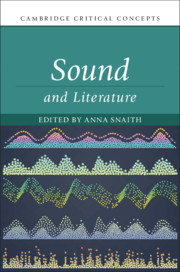Book contents
- Sound and Literature
- Cambridge Critical Concepts
- Sound and Literature
- Copyright page
- Epigraph
- Contents
- Figures
- Contributors
- Acknowledgements
- Introduction
- Part I Origins
- Chapter 1 Hearing and the Senses
- Chapter 2 Fragments on/of Voice
- Chapter 3 Sonic Forms
- Chapter 4 Classical Music and Literature
- Chapter 5 Aesthetics, Music, Noise
- Part II Development
- Part III Applications
- Bibliography
- Index
Chapter 3 - Sonic Forms
Ezra Pound’s Anti-metronome Modernism in Context
from Part I - Origins
Published online by Cambridge University Press: 29 May 2020
- Sound and Literature
- Cambridge Critical Concepts
- Sound and Literature
- Copyright page
- Epigraph
- Contents
- Figures
- Contributors
- Acknowledgements
- Introduction
- Part I Origins
- Chapter 1 Hearing and the Senses
- Chapter 2 Fragments on/of Voice
- Chapter 3 Sonic Forms
- Chapter 4 Classical Music and Literature
- Chapter 5 Aesthetics, Music, Noise
- Part II Development
- Part III Applications
- Bibliography
- Index
Summary
In 1912 Ezra Pound set himself in opposition to one particular sonic form: ‘the sequence of a metronome.’ With its symmetrical ticking or beating, the metronome became for Pound and some of his contemporaries an apt figure for a metrical tradition, often equated with an outmoded Victorian versification based on a regular succession of beats. In fact, the figure of metronome had been structuring debates about the appropriate sonic form of poetry for roughly a century before Pound issued his pronouncement about it. From the early decades of the nineteenth century, when Johann Maelzel’s musical chronometer began to offer a standard of temporal measurement for musical and vocal compositions, the metronome and practices attuned to its ticking featured regularly in elocutionary and prosodic literature. From the first tick of Maelzel’s machine to the modernism of Pound, a dispute about the practice of reading and reciting verse, as well as composing in it, found an apt correlate in the figure of the metronome. This chapter suggests that Pound’s anti-metronome modernism belongs to an evolving debate about a culture of sing-song and deliberately repetitive prosody.
Keywords
- Type
- Chapter
- Information
- Sound and Literature , pp. 74 - 91Publisher: Cambridge University PressPrint publication year: 2020



